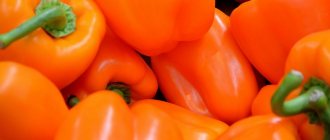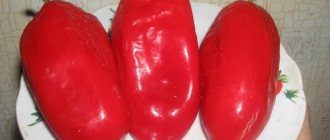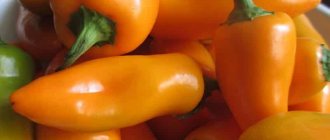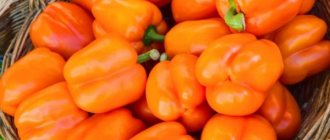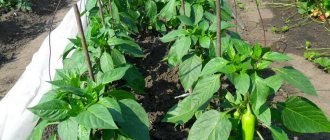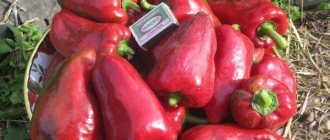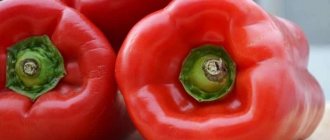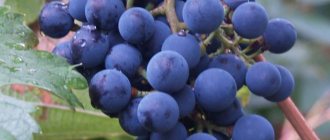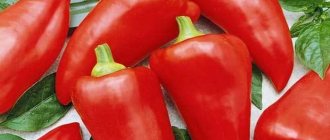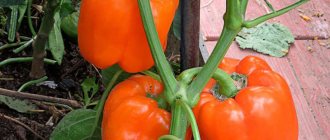Vegetable growing » Pepper
0
1217
Article rating
Kira Stoletova
Pepper Fat Baron category f1 is a high-yielding sweet pepper variety characterized by large fruits; it has gained great popularity among gardeners. Let's look at the description of the variety in more detail.
Pepper the Fat Baron
Description of pepper variety Fat Baron
Pepper Fat Baron belongs to the mid-early species. From the emergence of seedlings to the achievement of technical maturity of the crop, an average of 90-100 days pass. The bushes grow about 100 cm. The leaves are dark green, medium in size, almost smooth.
There can be 3-4 chambers, wall thickness - 0.7-1 cm
Each bush can ripen up to 15 peppercorns at the same time. The fruits are shaped like a prism. Average weight is 200-350 g. The skin in technical maturity is green, and in consumer maturity it is red, shiny, smooth. There may be 3-4 cameras. Wall thickness – 0.7-1 cm. The taste is pleasant, the aroma is well expressed.
Important!
Fat Baron peppers are most often planted in open ground. It grows well outdoors and produces large yields, but to obtain an earlier harvest, you can use a greenhouse or hotbed to grow this variety.
Choosing a medium-ripening variety
There are many varieties of peppers with an average ripening period. They are also worth adding to your garden. Vegetables ripen red, yellow or orange. Growing them is not only practical, but also very pleasant. Such fruits will decorate the garden plot.
Hercules
The plant is small in size, about 50 cm. It takes 110-135 days before fruiting begins. The peppers are cube-shaped and deep red in color. The weight of one piece is up to 140 g. 3 kg of crop is collected per square meter of plantings.
This plant can be planted in open ground or under cover; it resists many diseases. Used fresh and for preparations.
Golden-maned lion
Another variety with cube-shaped fruits. You need to wait about 110-135 days before the first vegetables. Forms a spreading plant about 50 cm. The peppers are large, weighing up to 270 g, rich yellow in color.
This variety is intended for conditions in the middle zone. It is planted in open ground or under cover in the form of a film. Resists many diseases and produces a bountiful harvest. Mainly used for salads and direct consumption.
Yolo miracle
There are 110-135 days before the start of fruiting. Plant up to 60 cm tall. Vegetables in the form of a cube, large - weight up to 300 g. The skin is red, the flesh is juicy. Designed for growing in open ground, under cover in the form of a film or in a greenhouse. Resists many diseases. Universal to use.
Fatty
This mid-season variety forms a bush of 50 cm. Vegetables with dense walls and a pleasant taste. The skin is bright red.
Siberian bonus
One of the best sweet peppers in the world. The vegetables are large, weighing about 200-300 g. The skin is dark orange with a glossy sheen, an unusual shade for sweet peppers. The plant is low, reaches 50 cm.
These vegetables are very tasty, a real gourmet will like them, their flesh is very tender. The wall thickness reaches 1.2 cm.
Siberian format
The plant forms taller bushes - about 70 cm. The vegetables are known for their excellent taste. The weight reaches 350-500 g, the skin is red, the wall thickness is about 1 cm.
Night F1
A high-yielding hybrid, bred not so long ago. It bears cube-shaped fruits weighing just over 100 g. It bears fruit abundantly; 5-7 kg of harvest can be harvested per square meter of planting. The skin is red. It is preferable to grow indoors.
Advantages and disadvantages of the Fat Baron
Also check out these articles
- Raising broiler chickens
- The best varieties of yellow peppers
- Veles grape variety
- Edilbaevskaya breed of sheep
Fat Baron pepper has unique qualities that distinguish it from other varieties. Gardeners say that it has both advantages and disadvantages!
- High immunity to Verticillium wilt, but can be affected by tomato bronze virus.
Pepper is of commercial quality, beautiful, smooth, does not bend, with a rich color
- The pepper is of commercial quality, beautiful, smooth, does not bend, with a rich color.
- Suitable for long-term transportation.
- Productivity per square of plantings is 7-11 kg.
- Fruits of universal use.
- Fat Baron pepper contains an increased amount of vitamin C.
Interesting!
It is recommended to plant bell peppers after legumes, cucumbers or cabbage.
Harvest and storage
Fruits are considered biologically ripe already on the 85th day of growth, after 30 days the technical ripeness of the crop occurs.
The best time for harvesting is considered to be the intermediate period, during which the fruits contain the maximum amount of nutrients. The first harvest occurs at the beginning of August and continues until the first frost. For better preservation, the vegetable is cut out along with the stem. A delay in harvesting fruits leads to a stop in the formation of the next ones. Thus, regular harvesting makes it possible to obtain up to 5 generations of harvest.
Pepper is quite demanding in terms of storage conditions and lasts very little. For these purposes, undamaged fruits are selected, part of the stalk is cut off and placed in places with temperatures at +8...+10°C. For longer storage, each vegetable is wrapped in paper. They also use plastic bags that do not allow air to pass through, and the products are stored in a carbon dioxide environment, which extends the shelf life.
Did you know? The ripeness of pepper is determined by a specific crackling noise when touched.
When planning to plant peppers, pay attention to Tolstyachok, which is known for its high nutritional properties and productivity. All the necessary parameters of the variety’s agricultural technology are indicated above, which allows you to fully realize its productivity.
Follow these recommendations and grow large and tasty fruits in your backyard.
Growing pepper seedlings
The easiest way to grow Fat Baron pepper is using the seedling method. Seeds for seedlings are sown approximately 75 days before planting the sprouts in a permanent place. You can sow them in a common container or individual cups (paper, plastic, peat). After sowing, the peppers are covered with soil so that the planting depth is about 1.5 cm, and sprinkled with clean, settled water from a spray bottle.
To create greenhouse conditions and provoke germination, the containers are covered with film or transparent, colorless glass. At a temperature of +26...+28 degrees, seeds germinate within 5-7 days. As soon as the sprouts appear, the film (glass) is removed.
The easiest way to grow Fat Baron pepper is using the seedling method.
Important!
The germination rate of Tolsty Baron pepper seeds is about 90%. According to gardeners, sprouts appear quickly if they are sown correctly and on time.
Seedlings need to be watered on time, making sure that the soil does not become crusty. When 2 whole leaves appear, you can plant the sprouts in separate containers, if they were in the same container. This culture does not like transplantation, so after picking you can notice a slowdown in growth. To prevent this from happening, the sprouts are sprayed with Epin after or during planting.
Planting Tolstoy Baron seedlings in the ground
We recommend reading our other articles
- How to feed strawberries in the fall
- Currant variety Dobrynya
- Apricot variety Black Prince
- How to grow an apricot from a seed
Peppers are planted in a permanent place after warm weather has established and the threat of return frosts has passed. Previously, seedlings can be planted in a greenhouse or greenhouse so that the plants are protected from cold weather and strong winds.
3-4 sprouts are placed per square meter of land
3-4 sprouts are placed per square meter of land. Holes are made for planting seedlings. Sprouts are laid out in them and sprinkled with earth. It is very important to ensure that the root collar is not buried. Plant the pepper at the same level at which it grew in cups.
Important!
Pepper grows best in loamy, loose soil with good aeration. Of course, before or during planting seedlings, it is advisable to fertilize the soil with compost, wood ash or mineral preparations.
List of common mid-early varieties
The best option is to plant peppers with different ripening periods on your plot. Then you can harvest fresh crops all season long, make salads and prepare food for the winter. Different varieties are planted in open beds or under shelters.
Latino F1
One of the mid-early hybrids, 100-110 days pass from the formation of seedlings to the start of fruiting. Produces cube-shaped red peppers. The bush grows up to 1 m tall. The weight of one piece is about 200 g. It is characterized by resistance to potato virus and tobacco mosaic.
These vegetables are intended primarily for growing in a greenhouse. Under optimal environmental conditions, 14 kg of vegetables can be obtained from one square meter of planting. Mainly used for salads, also suitable for direct consumption.
Golden Taurus
From the moment of seedling formation to the first harvest, about 110-115 days pass. The variety is distinguished by large cube-shaped peppers, their weight can reach 250-500 g, their color is yellow. The plant is 70-80 cm in height.
Suitable for growing in open beds, greenhouses or under cover. It bears abundant fruit. Resists a number of diseases. It is mainly used as an ingredient for salads.
Californian miracle golden
From the detection of seedlings to the start of fruiting, 140-150 days pass. The plant bears fruit within 50 days. Forms a low bush.
The fruits grow yellow, in the form of a regular cube. Vegetables reach 130 g, walls 5-6 mm. The variety is known for its excellent taste and abundant fruiting, and is universal in use. Can be eaten directly, used for cooking or canned.
Yellow cube F1
From the first shoots to the start of fruiting 110-115 days. Forms a strong bush, up to 1 m tall. Vegetables are quite large, well stored and transported. They have a marketable appearance. The plant resists the tobacco mosaic virus.
Vegetables grow weighing 250-300 g, walls 8-10 mm. As they ripen, they acquire a rich yellow hue and a pleasant aroma. Peppers with juicy flesh contain a considerable amount of sugar.
Agapovsky
One of the mid-early varieties, from the day the seedlings are planted until the first harvest is obtained, it takes 99-120 days. Forms compact bushes with dense foliage. Bears cube-shaped, red fruits. One medium pepper weighs 130 g, the walls are up to 8 mm. The plant resists diseases. It is preferable to plant in greenhouses.
Sources
- https://eteplica.ru/ovoshhi-v-teplicax/sladkij-perec-tolstyj-baron.html
- https://dachadizain.ru/ogorod/perec-tolstyj-baron.html
- https://fermilon.ru/sad-i-ogorod/ovoshhi/kubovidnye-sorta-pertsa.html
- https://DachaMechty.ru/perets/sorta-sladkogo-tolstostennogo.html
- https://FermoVed.ru/perets/tolstyj-baron-opisanie-sorta.html
- https://OgorodSadovod.com/entry/2954-perets-tolstyi-baron-opisanie-i-agrotekhnika-vyrashchivaniya
Pepper care
A high-quality harvest from this variety of bell pepper can only be expected with good care. Fortunately, he is not capricious and grows quickly.
- Watering is carried out as needed. The root system of peppers is moderately developed, so you should make sure that the soil is constantly moist. Peppers consume especially a lot of water during the flowering period.
- You can reduce the abundance and frequency of watering by spreading mulch under the bushes. You can use straw, peat or something similar. Mulch will protect the soil from overheating, will retain water, preventing it from quickly evaporating, and can also serve as additional nutrition for the roots of the plant.
- It is very important to remove weeds as they appear. They not only spoil the appearance of the site, but also reduce the yield of pepper.
- The soil is loosened when it becomes crusty. This is done so that a sufficient amount of oxygen reaches the roots.
Due to the heavy load (about 15 fruits per bush), the pepper must be tied up
- Although the Fat Baron pepper bushes are small, due to the heavy load (about 15 fruits per bush), it is necessary to tie up the plants, otherwise the pepper will tend to the ground.
Interesting!
On the hottest summer days, you can darken the pepper from the scorching rays of the sun. Thanks to this simple procedure, you can protect the leaves and fruits from sunburn.
- The bushes do not form much, you can only tear off all the leaves and side shoots before the first fork of the branches.
- The Fat Baron pepper responds positively to fertilization, so you need to feed it about 3 times a year. You can use minerals for this. In spring, the crop needs nitrogen, and during the formation of ovaries and fruits, potassium and phosphorus.
Peppers are harvested as they ripen. It is very tasty fresh, so it is often used to prepare fresh salads and snacks. Since peppercorns are quite large, you can use peppers of this variety for stuffing. Sometimes it is also put into winter preservation.
Planting and care
The choice of substrate for seedlings is approached responsibly: purchased in a store or prepared on the basis of garden turf.
The soil mixture should be loose, light, fertile. Potassium permanganate and Fitosporin are used for disinfection.
Seeds are sown from mid-February to mid-March.
How to sow and care.
- Seeds are planted to a depth of 2 cm, at a distance of 3 cm.
- Sprinkle a thin layer on top and irrigate.
- Cover with film and keep at 25 degrees until germination.
- After removing the polyethylene, maintain 20 degrees.
- Harden for 1 week at 14 degrees.
- Fertilize with Kemira or Krepysh.
- Dive and harden.
We suggest you familiarize yourself with: Do-it-yourself potato storage chest
Early maturing / Medium growing
User rating: 4/5
Mid-season / Mid-season
User rating: 5/5
Medium early / Medium height
The period after planting is quite important, because in order for the plant to take root and fully realize its productive qualities, it is necessary to create all the necessary conditions.
Watering
For this vegetable, moderate regular watering is recommended; the need for this is determined based on the condition of the top layer of soil: if it has dried out, the procedure can be carried out.
Fertilizer application
Plants planted in the ground are fertilized 3-4 times with a solution of chicken manure in a concentration of 1 part fertilizer to 10 parts water. Alternating it with mineral fertilizers.
A lack of nutrients is indicated by the appearance of the plant:
- the leaf curls and a dried border appears - lack of potassium;
- matte foliage with a grayish tint indicates nitrogen deficiency;
- The plant indicates its need for phosphorus by changing the color of the lower part of the leaf; it turns purple.
This moment should not be missed, because thanks to this the soil is saturated with air and perfectly passes water
Hilling should be done carefully so as not to damage the root system of the plant. For this purpose, the earth is raked to the base
During hilling, weeds should be removed.
There are four stages of the procedure:
- after the second watering, 2 days later, the soil is raked to a height of 6–8 cm;
- during flowering - by 10–12 cm;
- beginning of ovary formation - 14–16 cm;
- Peak fruiting is 6–8 cm.
As for the row spacing, they are loosened; 5 repetitions are enough for the season, adhering to a number of rules:
- before flowering, loosen to a depth of 12 cm;
- during the formation of ovaries - up to 15 cm;
- at the peak of fruiting - up to 25 cm.
Forming a bush allows you to increase the yield and size of the fruit itself. During the growth period, weak side shoots should be removed, as well as long ones should be shortened, getting rid of shaded areas. It is considered mandatory to get rid of all shoots growing below the main fork. Such manipulations are carried out every 10 days, as well as after each harvest.
Pepper diseases and pests
This variety does not have immunity to all diseases, so as it develops, it may be affected by one or another disease. If growth retardation appears, strange spots on the leaves, flowering is delayed or buds and ovaries fall off, it is necessary to urgently treat with fungicides. Good products include Trichodermin, Topsin-M, Maxim, Vitaros, Topaz, Fundazol, and Previkur.
Fungicides recommended for treating pepper diseases
Of the pests, the most problems are observed from mites, aphids, and slugs. As soon as they appear, the Fat Baron pepper bushes are sprayed with the insecticide “Aktara”, “Confidor”, “Slug Eater”, “Aktellik”, “Oxyx” or the like.
Diseases and parasites
This variety of sweet red pepper is immune to tobacco mosaic. Most often it is exposed to a fungal disease - verticillium. The main symptoms of this disease:
- lagging bush in development;
- the presence of deformed shoots;
- the presence of dark areas on the foliage.
Subsequently, the leaves begin to wither and fall off. You can get rid of this disease with the help of a drug such as Trichodermin.
The main parasites affecting the variety are slugs, aphids and spider mites. It is easy to get rid of them using chemicals such as Aktara or Oxychom.
SWEET PEPPER - REVIEW OF FOUR EXCELLENT VARIETIES! Sweet pepper, varieties Review of varieties of large-fruited peppers. The best varieties of thick-walled peppers 2021.
Reviews from gardeners about the Tolsty Baron pepper variety
Gardeners' opinions about the Fat Baron pepper are presented below.
- Petr Danilov : “Last year, Fat Baron grew peppers for the first time. The fruits turned out to be about 220 g, juicy, with a thick wall - just perfect. Of course, the yield was average, but this is not a reason to give up. This year I plan to repeat the experiment, but this time not in open, but in closed ground. Maybe this way the yield will increase.”
- Tatyana Romashko : “We live in the northern region of Russia, so we have to grow crops in greenhouses. Unfortunately, not all of them are well received and give birth; many lack sun and warmth. But the Fat Baron pepper showed its best side. It survived the transplantation of seedlings well, grew quickly, and produced a decent harvest! This year we made a lot of lecho and winter, canned salads with bell peppers. Now we will plant it every year, because it pays off the time and money spent on growing it.”
- Ekaterina Nosova : “I love Fat Baron for its taste, large size, meatiness, juiciness. It is versatile and suitable for any dish. I grow it outdoors. The bushes are moderately tall, but I always tie them up, because the amount of harvest can cause them to bend to the ground. As part of my mandatory care, I try to feed them 3 times a year and water them regularly. Of course, it is advisable to exclude any weeds, otherwise diseases and insects will appear.”
The thickest of peppers: a selection of varieties and hybrids
Sweet peppers are classified according to ripening time and growing conditions: there are greenhouse varieties, ground varieties, and also for forcing as a potted crop. Thick-walled peppers can be large or not very large, with different peel colors, oval and round. The main factor that makes it possible to classify a certain variety or hybrid as fleshy peppers is the thickness of the fruit wall from 7 to 10 mm, in some specimens - up to 12 mm.
It is believed that thick-walled peppers have sweeter and more aromatic flesh compared to thin-walled ones.
To succeed in growing your favorite vegetable and get a high-quality thick-walled pepper, juicy, with a pleasant aroma, you need:
- regularly (at least 2 times a week, and 3 times in hot weather) water the plants at the root (1 fruiting bush needs about 3-5 liters of water);
- loosen the ground and hill up the pepper a little - this is necessary for the stability of the central shoot;
- tie large-fruited varieties of thick-walled peppers to a support: the plant will be more stable, fragile shoots will not break under the weight of the crop;
- carry out from 3 to 6 fertilizing during the growing season, while alternating organic with mineral ones. This will help: improve the taste of the fruit (peppers are not aromatic and full-bodied if the plant does not receive enough moisture and nutrients);
- get fleshy (thick-walled) sweet pulp (it will not become sluggish and low-juicy at the time of biological ripeness);
- prolong fruiting.
Most thick-walled peppers are cube-shaped peppers with high yields. Basically, these are varieties, not hybrids, so you can easily collect seeds yourself for future sowings. Thus, I often collect seeds for planting from peppers purchased along the Rostov road or on the way to the Krasnodar Territory - local agronomists can offer really thick-walled varieties. Usually sellers do not deceive, they honestly say whether it is a hybrid or a variety, and even explain how to care for the plant. That’s why I call my fleshy peppers “southern fatties.” Of the professional seeds, the favorites in our beds are Orange Bull (mid-season) and Fat Baron (early): they bear fruit well at different times and never fail with yield, I leave my own seeds.
